Vol 4 No. 14 TROPIC LIGHTNING NEWS April 7, 1969
Index
WOLFHOUNDS SWEEP, DEFEND
Base Camps, 8 Cong Fall
DAU TIENG - In a five-day sweep of the enemy-infested Trapezoid,
Wolfhounds of Bravo Company, 1st Battalion, 27th Infantry, killed eight enemy
and discovered several small enemy base camps.
The 3d Brigade soldiers captured five AK-47 assault rifles, 500 lbs
of rice, almost half a ton of salt and destroyed 15 bunkers.
The Wolfhounds set up ambushes around each of the base camps they
discovered hoping to catch the enemy returning. In one instance they found
more enemy than they had bargained for, as a platoon of the riflemen had to hold
off an enemy company.
All in all, the five-day sweep was a big success.
"My men did a fine job in working in this difficult area," said
Captain Frederick G. Wong of Kahului, Maui, Hawaii, Bravo Company commander.
"Even when outnumbered. the company outfought the enemy and came out on
top."
In the action in which Wolfhounds were outnumbered, they fought
furiously detonating claymore mines and firing rifles while calling for
artillery and air support. After an hour's fight they swept six enemy
from the battleground.
The other ambush, which resulted in the death of two enemy, took
place a day earlier. Apparently this group consisted of a two-man North
Vietnamese Army patrol which the Wolfhounds spotted moving 100 meters from their
location.
All of the enemy dead in both actions wore uniforms indicating they
were North Vietnamese.
| DUST AND SMOKE fly in Fire Support Base Mahone as Up Tight cannoneers of Charlie Battery, 2d Battalion, 77th Artillery, fire in support of the 1st Battalion, 27th Infantry Wolfhounds. (PHOTOS BY SGT HECTOR NADAL) | 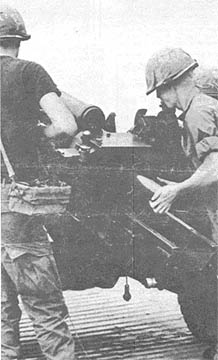 |
NVA Attack Routed
DAU TIENG - Wolfhounds of the 1st Battalion, 27th Infantry, killed
38 enemy, some inside the perimeter of Fire Support Base Mahone, as the enemy
attempted to overrun the camp during the predawn hours.
During the height of the battle, as five enemy charged inside the
perimeter across a blown bunker, the Wolfhound's battalion commander and
sergeant major personally led a counterattack that saved the position.
The fight was preceded by heavy sniper fire shortly after midnight.
The Wolfhounds blasted several enemy, then swept in front of their wire and
found that enemy sappers had cut away part of the perimeter.
Three hours later a much heavier attack began with a heavy barrage
of enemy 92mm mortars plus machine gun and rocket grenade fire.
The enemy identified as North Vietnamese Army soldiers wearing
green jungle uniforms, stormed the perimeter from a clearing after drawing many
Wolfhounds to the other side with a feint. The enemy also threw tear gas.
During the critical moments at the peak of the enemy assault,
gunners of Charlie Battery, 2d Battalion, 77th Artillery, lowered their 105mm
howitzers and fired point blank at the attackers.
At this point Lieutenant Colonel David S. Meredith III of
Annandale. Va., and Sergeant Major Walter F. Corvin of Vine Grove, Ky., led a
counterattack which halted the NVA advance.
Twenty-two enemy lay dead within a few yards of the sector,
including the five who came inside the wire.
When the attack ended, the 3d Brigade riflemen swept the area and
found numerous enemy weapons and items of equipment
| THE SOUND OF VIOLENCE - From left, Specialists 4 Arthur Stevens, Opelousas, La.; Leon Harris, Niota, Ill.; and Dewey Horn, Monroe, Mich., protect their ears as an 81mm mortar zips away from their tube at FSB Mahone. | 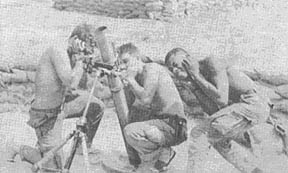 |
Army's Tribute to a Soldier, Statesman and Citizen
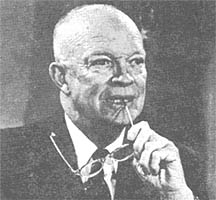 Editor's note: The following letter was received
from the Department of the Army in the Pentagon, upon the death of Dwight D.
Eisenhower. It is reprinted in full here as a tribute to one of
America's greatest citizens.
Editor's note: The following letter was received
from the Department of the Army in the Pentagon, upon the death of Dwight D.
Eisenhower. It is reprinted in full here as a tribute to one of
America's greatest citizens.
"We have the very sad duty to announce to the members of the
United States Army the death of General of the Army Dwight David Eisenhower,
34th President of the United States, who died at Walter Reed General Hospital,
Washington, D.C. at 1225 hours on Friday, 28 March 1969.
"General Eisenhower was a great American who distinguished
himself in a brilliant military career including service in two world wars and
an illustrious service in public life.
"As Supreme Commander of the Allied Expeditionary Forces in
Europe during World War II, he demonstrated his superb leadership by welding
this heterogeneous organization into the greatest fighting force the world has
ever known.
"As President of the United States during the Korean conflict and
during periods of serious international tension, he displayed a conscientious
loyalty to national ideals and a devotion to the principles of the dignity of
man which earned him the profound respect of people of the entire world.
"The United States will mourn the death of one of its greatest
military leaders and most distinguished citizens.
(Signed) STANLEY R. RESOR
Secretary of the Army
W. C. WESTMORELAND
General, U.S. Army
Chief of Staff
Page 2 TROPIC LIGHTNING NEWS April 7, 1969
Decorated
| ARMY COMMENDATION MEDAL (HEROISM) | |
| CPT Thomas E. Buck,
HHC, 2d Bn, 22d Inf CPT Harry K. Jowers, C Btry, 7th Bn, 11th Arty CPT Donald L. Strong, Co B, 25th Avn Bn CPT Carl Sweatman, HHC, 3d Bn, 22d Inf 1LT Donald P. Caldwell, Co D, 2d Bn, 27th Inf 1LT Dorothle J. Gillespie, Co D, 2d Bn, 14th Inf 1LT Gilbert D. Lilly, Co C, 2d Bn, 22nd Inf 1LT Michael D. Balser, HHC, 3d Bn, 22d Inf 2LT Miles I. Forsyth, Co D, 2d Bn, 27th Inf 2LT Thomas J. Bowes, Co D, 2d Bn, 27th Inf 2LT Martin H. Beach, Co A, 2d Bn, 12th Inf 2LT Craig Bambrough, C Btry, 7th Bn, 11th Arty WO2 Miner D. Cobb, HHB, 2d Bn, 77th Arty SFC Hubert H. Barnett, Adv Tm 99 SFC John Ellison, Co B, 3d Bn, 22d Inf SSG George Evans, B Trp, 3d Sqdn, 4th Cav SSG Donald L. Maiberger, Co A, 2d Bn, 22d Inf SSG Robert L. Horan, Co F, 50th Inf (LRP) SSG Ray H. Wallace, Co D, 2d Bn, 12th Inf SSG Forest F. Randolph, Co C, 65th Engr Bn SSG Anthony Ruffin, Co D, 2d Bn, 27th Inf SSG Charles Sweatt, C Btry, 7th Bn, 11th Arty SSG Bernard T. Hayward, B Btry, 7th Bn, 11th Arty SSG Adam M. Flores, B Btry, 7th Bn, 11th Arty SSG Michael Carey, C Btry, 7th Bn, 11th Arty SGT Gerald Vankirk, HHC, 3d Bn, 22d Inf SGT Jack C. Wurm, Co C, 1st Bn, 5th Inf SGT Guillermo L. Castillo, Jr., Co D, 2d Bn, 27th Inf SGT Ralph D. Allen, HHC, 2d Bn, 14th Inf SGT Richard L. Wade, Co A, 2d Bn, 22d Inf SGT Robert E. Clark, Co D, 3d Bn, 22d Inf SGT James E. Wallace, Co D, 2d Bn, 27th Inf SGT John S. Chattam, Co D, 2d Bn, 27th Inf SGT Loyd E. Lightfoot, C Btry, 1st Bn, 8th Arty SGT Kurtis M. Boyter, HHC, 3d Bn, 22d Inf SGT Mathine Resendez, C Btry, 1st Bn, 8th Arty SGT James Belmudez, C Btry, 7th Bn, 11th Arty SGT Larry D. Fetters, B Btry, 7th Bn, 11th Arty SGT Charles R. Collins, B Btry, 7th Bn, 11th Arty SGT George L. Bryant, C Btry, 7th Bn, 11th Arty SGT Charles R. Collins, B Btry, 7th Bn, 11th Arty SGT Donald Hutsell, C Btry, 7th Bn, 11th Arty SP5 Daniel 0. Pina, B Btry, 7th Bn, 11th Arty SP5 Tommy Morr, C Btry, 7th Bn, 11th Arty SP5 Luke S. Dease, Jr., A Trp, 3d Sqdn, 4th Cav SP5 Robert A. Acosta, C Trp, 3d Sqdn, 4th Cav |
SP4 Daniel Rothstein, A Co, 2d Bn, 14th Inf SP4 Gary Buchner, A Co, 65th Engr Bn SP4 William W. Gaddey, HHC, 3d Bn, 22d Inf SP4 Antonio R. Gonzalez, HHB, 2d Bn, 77th Arty SP4 Robert N. Lee, HHB, 2d Bn, 77th Arty SP4 William A. Spirk, HHB, 2d Bn, 77th Arty SP4 Ralph Wanke, C Btry, 7th Bn, 11th Arty SP4 Anthony Mantuano Co A, 2d Bn, 22d Inf SP4 Alvin L. Peckhem, HHC, 3d Bn, 22d Inf SP4 Seven L. Shafer, Co A, 2d Bn, 22d Inf SP4 Anthony Gouveia, Co D, 65th Engr Bn SP4 Dale C. Carlson, Co A, 2d Bn, 22d Inf SP4 Arnold Doll, Co D, 65th Engr Bn SP4 Renard R. Godwin, Co D, 1st Bn, 5th Inf SP4 Theodore C. Angus, Co C, 2d Bn, 22d Inf SP4 Ronald J. Pavlak, Co D, 2d Bn, 27th Inf SP4 Clarence E. Wilson, Cob, 2d Bn, 27th Inf SP4 Henry J. Eldridge, Co D, 2d Bn, 27th Inf SP4 Jose J. R. Mayo, Co A, 2d Bn, 34th Armor SP4 Percy K. Oviatt, Co D, 2d Bn, 27th Inf SP4 Richard W. Zimmerman, B Trp, 3d Sqdn, 4th Cav SP4 Ronald E. Wachtler, Co A, 2d Bn, 34th Armor SP4 Aguilar E. Perez, Co D, 2d Bn, 27th Inf SP4 John D. Eli, Co D, 2d Bn, 27th Inf PFC Fred Gambarella, D Co, 3d Bn, 22d Inf PFC Victor Tarmasjewicz, A Co, 65th Engr Bn PFC Douglas Syvertson, HHC, 3d Bn, 22d Inf PFC Melvin Blair, D Co, 2d Bn, 14th Inf PFC Haskell Grogan, D Co, 3d Bn, 22d Inf PFC James Rimble, B Trp, 3d Sqdn, 4th Cav PFC Gary Crabbe, 25th MP Co PFC Lambert A. Jacquot, Co C, 65th Engr Bn PFC Jerry W. Davis, Co A, 2d Bn, 27th Inf PFC Perry C. Clevenger, Co A, 2d Bn, 27th Inf PFC Forrest Janis, C Btry, 2d Bn, 77th Arty PFC George McDonald, Co B, 2d Bn, 12th Inf PFC Oliver J. Parr Jr., Co A, 2d Bn, 22d Inf PFC Stephen L. Nelson, Co A, 2d Bn, 22d Inf PFC Jerry Parker, Co. A, 2d Bn, 22d Inf PFC Clark A. Brooks, HHC, 3d Bn, 22d Inf PFC Jimmy Page, Co B, 1st Bn, 27th Inf PFC Eugene W. Olnes, Co D, 2d Bn, 27th Inf PFC Gregory A. Lieberman, Co D, 2d Bn, 27th Inf PFC James N. Hochthanner, Co D, 2d Bn, 27th Inf PFC Joseph Liggens, Co D, 2d Bn,, 27th Inf PVT Leroy Cochran, A Co, 1st Bn, 5th Inf |
Tropic Lightning Tots
The Commanding General Welcomes
The Following Tropic Lightning Tots
To The 25th Infantry Division - As
Reported By The American Red Cross.
Born To:
March 4
PFC Roy L. Walsh of Co A 2/14th Inf, a daughter
March 5
SP5 Vallas C. Thacker of Trp C 3/4th Cav, a daughter
SP4 Samuel J. Goss of Co E 2/12th Inf, a son
March 6
SGT William D. Brown of Co B 2/14th Inf, a son
March 7
SGT Manuel Aguiar of 38th Inf Pit Sct Dog,,a son
SP5 Donald M. Simpyon of Co 2/34th Armor, a daughter
March 8
CPT John M. Omeara of HHC 25th Inf Div, a daughter
March 9
SP4 Phillip C. Woolford of Hq Co A 725th Maint Bn, a daughter
March 10
SGT Clydell Greer of Co E 725th Maint Bn, a son
March 12
SP5 Charles G. Jackobson of Co B 65th Engr, daughter
March 13
SP5 Willie J. Marshall of Hq Co A 725th Maint Bn, a son
March 14
SP4 Jose S. Paz of Co A 2/12th Inf, a daughter
March 16
SGT David D. Anderson of Co A 1/5th Inf, a son
March 18
SP5 James De Bruin of HHC 25th Inf Div, a son
March 19
PFC Billy D. Miller of Trp C 3/4th Cav, a son
March 20
PFC Andrew J. Kaier of HHC 2/34th Armor, a son
SP5 John E. Hacker of HHB 1/8th Arty, a son
SP4 Bobby W. Thomas of Co A 1/5th Inf, a son
PFC Hiram L. Arthur of LCLC 25th Inf Div, a son
March 21
SP4 Robert E. Donahue, Jr. of HHC 2/14th Inf, a daughter
March 22
PFC Elton E. Steinert of Co C 725th Maint, a son
Pot: A Known Danger
Why all the fuss about drugs?
Well may one ask. If it is rightly held to be alarming when
even one soldier is punished for drug use or possession, anyone with any
awareness of how profoundly unpleasant such punishment can be should know what
drugs can have to do with him and whose business it can be.
In the past few years there has been an increase in the misuse and
abuse of beneficial drugs as well as dangerous ones. The dangerous drugs,
like LSD, STP and marijuana - hallucinogens all - can cause permanent mental and
physical damage.
Marijuana, also known as pot or grass, is the most frequently used
of the hallucinogenic drugs. Very little is known about its long-term
effects, but it does not appear to be physically dangerous in its mildest form;
physical reactions to stronger forms vary with the individual. However,
marijuana in any form can cause psychotic reactions.
Marijuana's active ingredient, tetrahydrocannabini or 'THC,'
is potentially very dangerous.
Under the influence of marijuana, concepts of time and
space can be radically distorted, and emergency responses are unpredictable. Persons
under the influence of pot in a combat situation are at least as dangerous to
their comrades and themselves as to the enemy.
The sale, use or possession of such drugs is a violation of the
Uniform Code of Military Justice which prescribes up to five years in prison and
a dishonorable discharge as punishment.
| The Tropic Lightning News needs a cartoonist. If you have experience in this field and would like to see your work in these pages, please submit samples in India ink to Public Information Officer either in person or by courier. |
TROPIC
LIGHTNING
Combat Honor Roll
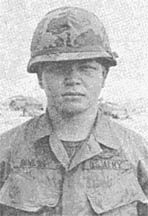 Added to the Tropic Lightning Combat Honor
Roll this week is Staff Sergeant George Bowling of Company C, 1st Battalion, 5th
Infantry, who has been awarded the Silver Star for bravery in action February
23.
Added to the Tropic Lightning Combat Honor
Roll this week is Staff Sergeant George Bowling of Company C, 1st Battalion, 5th
Infantry, who has been awarded the Silver Star for bravery in action February
23.
While on a reconnaissance-in-force mission, Company C came under a
deadly barrage of hostile fire from a well-entrenched enemy force.
Sergeant Bowling immediately directed his men into strategic fighting positions.
Spotting a track commander wounded and unable to fire his 50 caliber machine
gun, Sergeant Bowling exposed himself to the intense enemy fire as he moved to
the aid of the wounded man and replaced him on the vehicle.
Placing devastating fire on the aggressors, he ordered his men to
withdraw to allow supporting fire to engage the enemy. Unable to break
contact, Sergeant Bowling, with complete disregard for his own safety, secured
several hand grenades and advanced on the hostile emplacements destroying one
bunker with accurate grenade fire.
After artillery was directed on the hostile territory, Sergeant
Bowling led an assault on the insurgents' positions. His valorous
actions were instrumental in thwarting the aggressors, and served as an
inspiration to his men.
The TROPIC LIGHTNING NEWS is an authorized publication of the 25th Infantry Division. It is published weekly for all division units in the Republic of Vietnam by the Information Office, 25th Infantry Division, APO San Francisco 96225. Army News Features, Army Photo Features, Armed Forces Press Service and Armed Forces News Bureau material are used. Views and opinions expressed are not necessarily those of the Department of the Army. Printed in Tokyo, Japan, by Pacific Stars and Stripes.
MG Ellis W. Williamson . . . . Commanding General
MAJ John C. Fairbank . . . . . Information Officer
1LT John C. Burns . . . . . . . . Officer-in-Charge
SP4 Stephen Lochen . . . . . . Editor
SP5 Charles Withrow . . . . . . Assistant Editor
SP4 Jim Brayer . . . . . . . . . . . . Production Supervisor
Page 3 TROPIC LIGHTNING NEWS April 7, 1969
NVA Lieutenant Rallies to GVN
TAY NINH - A North Vietnamese Army second lieutenant rallied his
way right into the midst of a group of South Vietnamese officials and Tropic
Lightning soldiers celebrating Tet in a small village near the Cambodian border
recently.
The GIs were from the 4th Battalion, 9th Infantry Manchus and B
Battery the 2d Battalion, 77th Artillery, who had come to the village of Ben Cau
from the Manchus Fire Support Base Sedgewick, 15 miles southeast of Tay Ninh and
a half-mile from the village.
The Americans were in the village to distribute gifts to civilian
and military officials, and were sitting down to lunch when guards brought in
the NVA rallier.
In an impromptu 10-minute speech delivered through an interpreter,
the North Vietnamese officer - who was a mortar platoon leader with a unit
operating out of Cambodia, said he had waited for a long time for an opportunity
to surrender.
"Most of our leaders have been killed, and we've been very low
on supplies for a long time," the interpreter quoted the rallier. "I
know there are many more of our men who would come over to the South Vietnamese
side if they had the chance."
For the Manchus, who had been in contact with NVA forces in the Ben
Cau area two days earlier, the surprise rallier was a shock.
The battalion's B Company commander; Captain George H. Dias Jr.,
Fayetteville, N.C.; described it as "an amazing experience."
"There I was, standing right across the table from a man who may
well have been trying to kill me two days ago," Dias said later, still shaking
his head incredulously. "It was hard to believe we were standing there
in the same place, looking at each, other."
The leader of the Manchu delegation to the Tet celebration,
headquarters company commander Captain Roosevelt Ludd, Columbus, Ga., agreed
with Dias.
"I don't think I've ever been more surprised in my life than
I was when I saw that man," Ludd said.
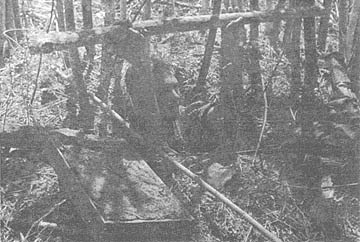 |
DAVY CROCKETT - Sergeant Ken Kuhl of Melrose Park, Ill., emerges from a tunnel with an old VC zip gun. The 2d Battalion, 27th Infantry, soldiers were on a sweep of the area southeast of FSB Reed when the discovery was made. (PHOTO BY SP4 KARL KARLGAARD) |
These Dogs Are Trained for Scoutin'
DAU TIENG - Deep in a humid jungle near the edge of War Zone C, a man
watches intently as his dog works his way through the dense vegetation.
Suddenly the dog freezes. "Hit it, you guys," the dog
handler yells out as a squad of infantrymen ducks for cover.
The scene is repeated almost daily for men of the 3d Brigade as
they work with scout dogs of the 44th Infantry Platoon.
During 800 missions that the dogs took part in last year the
brigade found 1,200 bunkers, 16 base camps and killed 480 enemy. On many
occasions the dogs have saved GI's from booby traps, snipers and ambushes.
"I trust my dog more than I trust myself," one dog handler
said. "If he gives an alert, I know he doesn't smell water buffalo.
The 'little man' is around somewhere."
The only flaw that the animals have is that they aren't as well
suited to Vietnam's heat and humidity as are the more rugged infantrymen.
"After about five days, we've got to bring in the dog and his
handler. The dog will lose weight in the field," said Lieutenant
Lawrence H. Hughes of Brookside, N.J., commander of the scout dogs. In a
few instances after long sweeps, the dogs have been medically evacuated from
heat exhaustion.
In order to familiarize combat leaders with the dogs' abilities,
Hughes has begun a regular orientation program to put the dogs through their
paces.
The 45 minute show has the dogs jumping, running and sniffing their
way through an obstacle course of barrels, tunnels and barriers. They
follow with a display of obedience drills.
The dogs begin their military careers as part of the Air Force
sentry dog program, then transfer to the Army for further training at Fort
Benning, Ga., before journeying to Southeast Asia.
The 44th Platoon has enough scout dogs and handlers to support
three battalion of infantry, according to Hughes. The big dogs, mostly
German Shepherds, are more versatile than many commanders realize.
Surprisingly, the dogs are a big favorite with the brigade's
mechanized battalion, the 2d Battalion (Mech), 22d Infantry, "Triple Deuce,"
and have adapted well to working with armored personnel carriers.
In some instances the dogs have given alerts on enemy up to 300
meters away. The wind and type of terrain greatly influence how far the
enemy's scent carries.
The dogs are so faithful to their handlers that, in cases where
their masters are wounded, they sometimes have refused to let anyone near the
victim. Despite such loyalty, the dogs often befriend different handlers
and adjust quickly when a member of the platoon goes home.
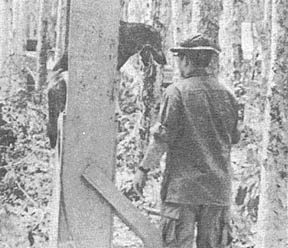 |
AS HIS DOG labors to negotiate an obstacle, a handler with the 44th Infantry Platoon (Scout Dog), puts the animal through its paces for benefit of unit commanders and operations officers of the 3d Brigade. (PHOTO BY CPT R. A. STEINHAUSEN) |
3d Brigade's Artillery AO's Get Bird's Eye View of VC
DAU TIENG - Artillery spotters at the 3d Brigade's base camp have
their heads in the clouds to keep an eye on Charlie.
Perched high above the rest of the camp at Dau Tieng are three
spotting towers manned by soldiers of 1st Battalion, 27th Artillery.
These towers offer a clear and unobstructed view of the camp
perimeter and artillery spotters can easily sight enemy mortars and rocket
launching sites miles away in the heavy undergrowth.
Within seconds after one of the spotters relays his reported
sighting to the Fire Direction Control Center, base camp artillery is putting a
crimp in Charlie's plans for a rocket and mortar attack.
Artillerymen from firing batteries of the 1st Battalion, 27th
Artillery, 2d Battalion, 77th Artillery; and 5th Battalion, 2d Artillery, can
put a payload where it counts only when accurate information is relayed by the
spotters.
"The area around the Dau Tieng base camp offers us a pretty good
view of Charlie's positions, so we add aspects of our defense against rockets
and mortars (DARMA) to data recorded by our spottings to come up with a very
effective program against the enemy," said Specialist 4 Richard Swidrack of
Westlake, Ohio, spotter for 1/27th Arty.
|
AN EYE OUT - Specialist 4 Richard Swidrak of Westlake, Ohio, keeps an eagle eye on enemy rocket launching sites and mortar positions by using a battery commander's telescope. After an enemy position is spotted, Swidrak adjusts artillery fire with the aid of the scope. (PHOTO BY 1LT J.M. O'BRIEN)
|
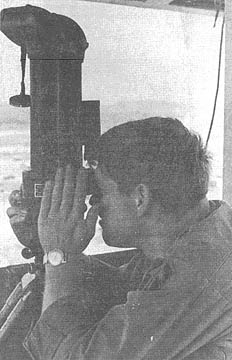 |
Page 4 TROPIC LIGHTNING NEWS April 7, 1969
Waterborne Warriors Join Forces to
Hunt Charlie in his Own
Backyard
|
Story and Photos by 1Lt. J. N. Black |
CU CHI - While South Vietnamese soldiers in small 'ragboat'
patrols made daily sweeps of the Saigon River northwest of Saigon, 2d Brigade
Wolfhound and Golden Dragon troops patrolled the Oriental River to the northwest
under a combined operation nicknamed Keelhaul.
The operation was aimed at halting enemy movement and locating
riverbank caches. It combined the efforts of the Army, Navy, Air Force,
and Vietnamese elements.
Tropic Lightning's Fire Brigade soldiers learned a new type of
warfare, taking hints from green water sailors, and riverines from the 9th
Infantry Division, who are 'old salts' at waterborne tactics.
"This kind of operation is all new to the 25th Division," said
Navy Lieutenant James Kelley, Tango boat captain, "but we can show them all
they need to know in a few days. We do these kinds of operations all the time in the Delta
region," he added, "and we've found them successful."
The operation, nicknamed Giant Slingshot by naval operations at
Dong Tam, is conducted on major III Corps area rivers with the intent of denying
the enemy use of prime waterways. Both large and small boats are used in
the operations. The larger Alpha boats carry heavy weapons and offer a
little more stability, but the Tropic Lightning soldiers prefer the large
Auxilliary Troop Carriers (ATC) or Tango boats.
Put ashore by the Tangos, the troops can sweep in regular infantry
fashion or move into the canals to search for VC supplies.
The operation is supported by Task Torce 117 of Riverine Division
92, Riverine Assault Squadron 9.
The combination of sea power and Army firepower is a devastating
force with shock power, but lack of concealment on the river requires constant
alertness.
"If we get in a firefight, said Kelley, "we can react
immediately with our weapons, but we rely heavily on artillery and air
support."
"On Tango boats," he continued, "we have two 50mm, four 30mm,
and one 20mm machine guns. We also have the Honeywell automatic grenade
launcher that can put out about 250 rounds a minute."
"And of course," added Kelley, "when we have the enemy pinpointed
we can put the troops ashore."
One Wolfhound soldier of Company C, 2d Battalion, 27th Infantry,
said, "These river operations are okay for a while, but I wouldn't want to
do it for a long time. Hopping off into a firefight on the edge of a river
without knowing exactly what you're going into can get a little hairy."
But the Wolfhounds have long trudged the rice paddies and streams
of central III Corps' Hau Nghia Province. "We know what it's like
fighting in the water," added the soldier. "We have a lot to learn here, but
we can do it."
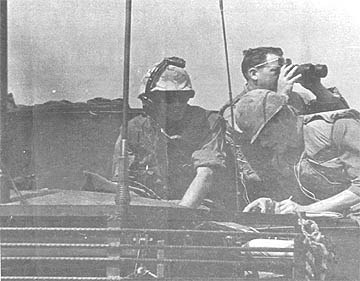 |
JOINT FORCES of Army Lieutenant Robert Parson (left), Wolfhound artillery forward observer; Air Force Major Maxwell Snider, Fire Brigade assistant air liaison; and Navy Lieutenant James Kelley, Tango boat captain, helped tackle Charlie whenever he poked his head out during operation Keelhaul. |
| COMING ABOARD after a 45-minute sweep in mud and swamp frequently waist high was a great relief. The Wolfhounds swept from one riverlet to another continuing the riverine assault. | 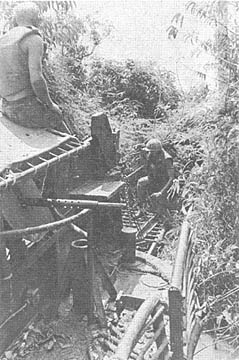 |
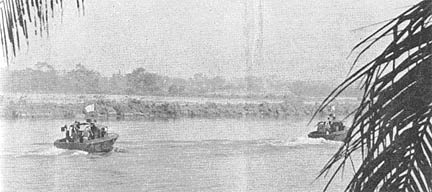 |
AMONG RAPID WAR BOATS of the Navy's mobile riverine force working on the Oriental River northwest of Saigon are these fast-acting and deadly patrol boats. |
| AFTER LEAVING TANGO BOATS, Wolfhound troops from the 2d Brigade sweep down marshy riverbanks in search of bunkers, caches, sampans and Charlie. | 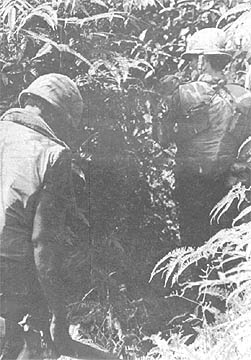 |
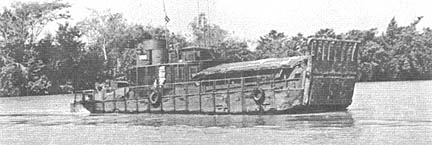 |
CREW AND INFANTRYMEN ABOARD, the Tango boats churn up river in search of VC and NVA in their hidden domain. |
| WAITING FOR MOVEMENT - A Wolfhound soldier stands at the gate of a Tango boat. The area was swept twice that morning. That night the Wolfhounds found the enemy. | 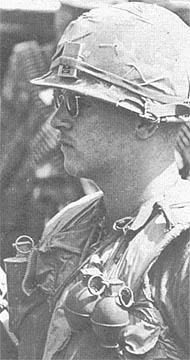 |
Page 6 TROPIC LIGHTNING NEWS April 7, 1969
Combat Caloused 'BoShank' World's Only Career Mascot
By SP4 Larry Vall Longa
CU CHI - BoShank, a three year old charcoal black mixed terrier,
has seen two and one-half years of combat service in South Vietnam.
BoShank's home is with Bravo Troop, 3d Squadron, 4th Cavalry.
The dog knows no other life except that of combat trooper. Ever since he
was a pup the blasts of main guns and automatic weapons have rung in his ears.
He has grown to be the most respected pet the field troopers have.
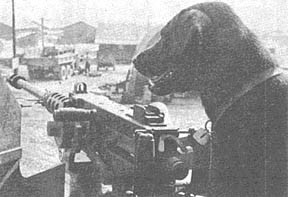 "BoShank has witnessed more firefights than any man in Bravo
Troop," explained Specialist 4 David Nelson, Lafayette, Ind., BoShank's
master.
"BoShank has witnessed more firefights than any man in Bravo
Troop," explained Specialist 4 David Nelson, Lafayette, Ind., BoShank's
master.
Nelson also comments, "Ol' faithful BoShank has warned the
cavalrymen on several occasions of enemy movement during the night. I
guess he knows the smell of an AK-47 or something. He'll give a sharp
howl and at the same time turn his ears straight back. During ground
operations he seems to smell out Charlie. He walks the jungles with the
rest of the men and screens out all dangers. Sometimes he will peer into
tunnel complexes just to see what is inside."
Scout dogs in Vietnam are very helpful to infantry units. The
dogs are trained to sniff out Charlie, his booby traps and routes of travel.
Even though BoShank has had no classes in scouting, what German
Shepherd could be trained to pull guard up in the tank commander's cupola?
A truly combat-minded animal, BoShank will place himself behind the huge 50
caliber machine gun and sit there calmly watching for any movement to his front.
For this reason BoShank was awarded the honorary rank of staff sergeant.
"BoShank is a career soldier, with his stomach in and his chest
out," comments Nelson. "Two and one-half years in the field,
participating in every cavalry battle, is a long time for any trooper.
Sergeant BoShank has seen plenty of action and we feel he deserves a break."
At present, the old hound has a desk job back in Cu Chi base camp.
To stay in good health, Sergeant BoShank rises bright and early. He
is present at all formations. During the evening police call BoShank leads
his men through the troop area. Every so often BoShank will visit the
bunker guards just to make sure everyone is alert.
When the enemy attacked Cu Chi's eastern perimeter, BoShank made
great efforts to ward off the attackers. Low crawling from bunker to
bunker, BoShank made his rounds to reassure the men that everything was okay.
In one incident during the battle, BoShank crouched in readiness on top of one
of the bunkers. He sat there ready to pounce on anything that came near
him.
Sergeant BoShank, serial number K9-007, is truly an animal with
great pride and is, by all means, the best mascot the cavalrymen could have.
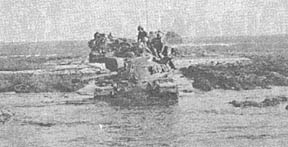 |
CAUTIOUS ENTRY - Dipping Into a wide stream, this C Company, 2d Battalion, 34th Armor, tank cautiously tests the ground's strength. (PHOTO BY SP5 DOUG ELLIOTT) |
Cut NVA Probe Short
DAU TIENG - Fighting Wolfhounds of Charlie Company, 1st Battalion,
27th Infantry, stopped a North Vietnamese Regular Army unit dead in its tracks
recently at Fire Support Base Mahone.
When the battle ended, the Wolfhounds counted nine dead NVA and
took three prisoners. There were no friendly casualties.
It was the third time in a week that the 3d Brigade soldiers routed
an NVA assault before it could develop.
Specialist 4 John T. Manglona of Inarajan Village, Agana, Guam, was
in the midst of the action.
"I was on bunker guard at the time. I spotted about five
NVA by the perimeter wire. Then I called the Charlie Company command post
and requested illumination. When the illumination rounds came in, three
other guys and I fired at the NVA," he said.
In addition to the body count, the Wolfhounds captured 10 enemy
weapons including AK-47 rifles, an RPG-7 launcher, web gear and documents.
"The troops performed magnificently in every respect," said
Lieutenant Colonel James T. Bradley of Arlington, Va., the battalion commander.
Bobcat Medics Stymie Village's Plague Scare
CU CHI - When the death of a small girl hinted at a plague outbreak
in the village of Trung Lap the medics of the 1st Battalion (Mechanized), 5th
Infantry swung into action.
The Fire Brigade medics in cooperation with the Vietnamese
government and help from battalion civil affairs section headed by First
Lieutenant Harry Clark, Brooklyn, N.Y., administered 3,600 preventive plague
inoculations. Twenty cases of plague were discovered and treated.
The victims recovered indicating the threatened outbreak was under control.
Nearly a month later three deaths in Trung Lap's hamlet of Ap Don
showed that the plague was reappearing. In addition, 12 reported cases in
the village caused further alarm.
A full-scale campaign was now underway to completely eradicate the
plague and its causes. DDT supplied by Military Assistance Command Vietnam
(MACV) was used to dust 950 homes with the powder which kills the plague
carrying fleas. The fleas are carried by rats attracted by freshly
harvested rice.
Chi Tich, the village chief, directed his people to the inoculation
site, a civil affairs section loudspeaker site.
Captain Roy P. Hodge, Butte, Mont., Bobcat surgeon, reported that
during the second bout with the plague his men administered 3,800 inoculations
to civilians plus 400 to local Army Republic of Vietnam soldiers in a three-day
period. Hodge estimated that 80 per cent of the Trung Lap populace
received a plague inoculation.
A few days after the vaccine was administered, the village chief
gave an elaborate "Thank You Dinner" for Captain Hodge and presented him
with a certificate of appreciation from the people of Trung Lap.
The dinner was a big affair with the guest list including each of
the hamlet chiefs and their families, the Bobcat medic staff and civic action
personnel.
Vietnamese delicacies eaten with the traditional chopsticks gave
most of the GI's a new experience.
One of the highlights of the event was the handing out of school
kits containing paper, ink, crayons, rulers, notebooks, pens, and pencils given
by the 2d Brigade soldiers.
Aside from donating school kits, the mech unit passed out bright
yellow, red-striped caps and T-shirts for the school children.
Polished rice recently captured by the Fire Brigade soldiers was
distributed to the villagers.
Page 7 TROPIC LIGHTNING NEWS April 7, 1969
Weyand Returns to Tropic Lightning
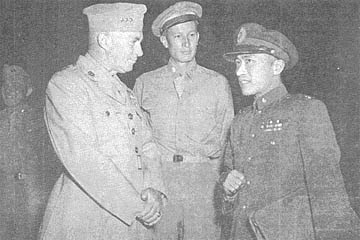 |
1945 - Lieutenant Colonel Weyand represents the commander of the Army ground forces in the Pacific in a conference at Hawaii with General Allen H. Turnage, commander of the fleet marine force, and Chinese General Peter T. K. Fee. |
Lieutenant General Fred C. Weyand was right at
home in the division when he stopped in for a short visit recently. One
star ago, it was home.
When the Tropic Lightning Division deployed in Vietnam in 1966, it
was under the command of Major General Fred C. Weyand. Since that time he
has been commander of III Corps and adviser to presidents and peace conferences
on the Vietnam war.
General Weyand was born in Arbuckle, Calif., in 1916. His
military career began in 1938 when he was commissioned a second lieutenant in
ROTC upon his graduation from the University of California. Called to
active duty in 1940 with the coast artillery, he was assigned to the War
Department for special schooling in intelligence work in 1943.
After intelligence work in Burma and India with General
Stillwell's headquarters, he was assigned to the headquarters of the China
theater in Chungking.
During the Korean War he served with the 3d Division in Japan and
Korea, commanded the 1st Battalion, 7th Infantry, through five battle campaigns
and rose to the post of division operations officer.
In 1954 he was assigned to the staff of the Secretary of the Army,
after attending the Armed Forces Staff College. During this time he
advised then Vice-President Richard Nixon. In 1957 he attended the
National War College and was assigned to the Berlin garrison the next year.
After three years in Washington in a legislative liaison capacity,
he assumed command of. the Tropic Lightning Division at Schofield Barracks in
1964.
Ex-Tropic Lightning CG is One of United States' Most Respected Soldiers
| 1969 - Brigadier General Black awards the Gallantry Cross with palm to Lieutenant General Weyand before a briefing in division headquarters. | 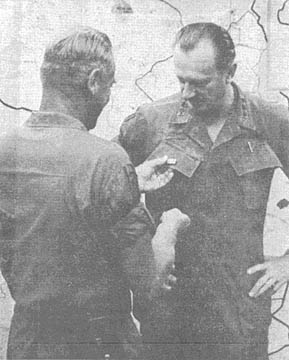 |
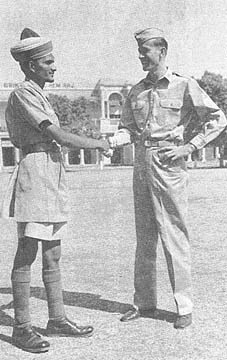 |
1945 - An Indian officer at the New Delhi headquarters of the India-Burma theater congratulates Weyand on his promotion to lieutenant colonel. |
| 1959 - Secretary of the Army Wilber M. Brucker talks with Colonel Weyand, then, commander of the 3d Brigade, 6th Infantry of the Berlin garrison. | 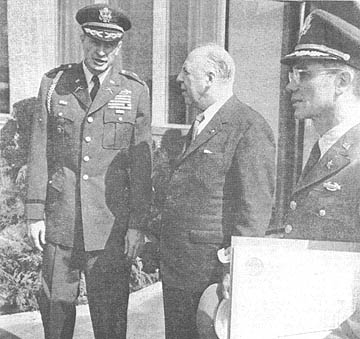 |
Page 8 TROPIC LIGHTNING NEWS April 7, 1969
The Perfect Combination
Armor Rolls, Cats Claw, NVA Fall
Story and Photo by 1LT J.N. Black
CU CHI - The combination of armor power and Tropic Lightning
determination in the 2d Brigade recently formed a steel wedge that dug into VC
flanks and immobilized an NVA unit.
Working with ARVN infantry and cavalry units, the Fire Brigade
soldiers tallies 40 NVA killed and numerous captured weapons.
The 2d Brigade's 2d Battalion, 34th Armor, rolled through the
dusty back gates of Cu Chi laden with steel machinery and ammo into the Filhol
Plantation.
The fire-hardened Dreadnaught task force searched for hard core NVA
units and buried supplies reported to be in the area.
They headed across country in M-48 tanks and armored personnel
carriers to rendezvous with elements of the 1st Battalion (Mechanized), 5th
Infantry, and ARVNs of the 2d and 4th Battalions, 7th Infantry.
In the same area two days earlier, the Bobcats had tackled a
tenacious enemy force and killed 22 while 2d Battalion, 14th Infantry Golden
Dragons killed 12 more.
By the end of the first phase of the operation, the units along
with elements of ARVN 1st Cavalry had participated in four engagements and
regrouped for phase II and an upcoming battle that would test their mettle.
The first minor engagement began on the site of the last grueling
battle, when the Bobcats encountered the same NVA force, dug in and determined.
The battle continued for two days. Sapping the enemy's
supply and resources the combined US and ARVN forces engaged the enemy in a
dense hedgerow complex battling until late at night.
The Cats' Alpha Company took a principal role In the fight.
Individual soldiers maneuvered ahead of their armor support, seeking cover among
brush and hedgerow camouflage, to place fire on the enemy.
"Acts of heroism were numerous," said Bobcat A Company
commander, Captain Randall Yeargan, San Antonio, Tex. "Al-C drivers and
gunners were standing on their tracks throwing grenades and shooting into the
trenches."
The US and ARVN elements uncovered 14 AK-47's, 5 RPG launchers
with 25 rounds, two RPD light machine guns, one 60mm mortar complete with 15
rounds, one 30 caliber machine gun with carriage, 40 CHICOM hand grenades, seven
82mm mortar rounds and 40 pounds of butterfly bombs.
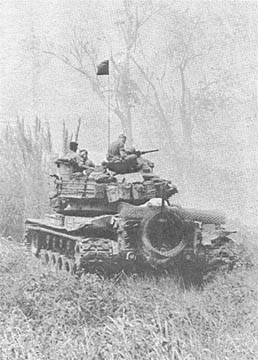 |
WAIT ONE - Tankers from Headquarters Company, 2d Battalion, 34th Armor, take a break in place during intensive operation in the Filhol Rubber Plantation north of Cu Chi. |
Triple Deuce Kills 51 NVA in Fight
DAU TIENG - The combined firepower of the Triple Deuce, artillery
and air strikes killed 51 North Vietnamese Army soldiers in a fierce battle
three miles northwest of the 3d Brigade base camp at Dau Tieng.
The operation began when mechanized infantrymen of the 2d
Battalion, 22d Infantry, rolled their armored personnel carriers to the edge of
an enemy reinforced battalion's base camp and started a
reconnaissance-in-force mission in the surrounding jungle area. They received
enemy small arms and RPG fire almost immediately.
Captain Raymond W. Kauffman of Lexington, Ky., Charlie Company
Commander, dismounted his men and fought forward through dense undergrowth to a
tree line about 100 meters in front of the tracks where the enemy barrage was
coming from.
At times forward infantrymen were fighting within five meters of
the enemy fortification. As night fell, the U.S. soldiers pulled back to
direct artillery and air strikes into the bunker complex. A quick search
of the area revealed 51 enemy bodies.
Give Water The Works
TAY NINH - One enormous task in South Vietnam often overlooked is
water purification - overlooked, that is, by everybody except the water
purification specialist.
Everyday the water specialist must test and treat the water that is
to be marked 'potable,' safe to drink.
The 4th Battalion (Mechanized), 23d Infantry, is using the services
of two water purification men, Specialist 4 Robert Fryman of Cynthianan, Ky.,
and Private First Class James McCray of Pawling, N.Y.
The men have a full time job treating the battalion water supply,
and keeping the local wells around Tomahawk fire support bases maintained.
The Tomahawks aren't the only ones benefiting from the services
of the water purification men, however. The local villagers are finding
their water much safer to use now because the purification specialists are
treating their wells too.
"The local villagers get a kick out of watching us test and treat
the water in their wells," said Fryman. "They've never seen an
operation such as ours. It's a daily get-together when we start treating
the water. They all gather around to cheer us on."
McCray commented, "It's a rewarding job knowing that you're
improving the living conditions of the local people. Sickness caused by
bad water will cease to exist, and the water will even taste better."
Mech Units Rock Cong Companies
CU CHI - Mechanized infantry elements of the 2d Brigade held off an
estimated two reinforced Viet Cong companies, following an ambush on the Fire
Brigade unit.
As morning moved into early afternoon there seemed no break in
sight from the dull monotony of a day's sweep. But most of the Tropic
Lightning soldiers knew that the possibility of enemy contact was high.
Suddenly, without the slightest warning, a flash and streak
appeared from a hedgerow which the experienced Fire Brigade soldiers identified
immediately as a rocket-propelled grenade.
A split second later, the hedgerows came alive with the sound of
AK-47 fire on both sides of the infantrymen.
At the front of the column, a Fire Brigade tank was taking nearly
everything the VC could dish out. While the PC's 50 caliber gunners were
raking the hedgerows, the tankers continued to fight back with their 90mm
cannons, matching round for round.
The company survived the critical first minutes and aggressively
countered the surprise attack. The unit commander, Joseph Bane of Carmel, Calif., ordered
his company into a defensive perimeter to give the unit firepower on all sides.
The size of the enemy force and their capabilities from the
well-fortified positions dictated the use of gunships and air strikes.
Meanwhile aloft, Lieutenant Colonel William Klein, battalion
commander, observed and supervised the counter assault from a light observation
helicopter.
As the commander circled the area, menacing sniper fire whizzed
around his ship. Suddenly a round hit the craft and started it on a
downward plunge into VC-occupied area.
Over the radio, Klein's voice calmly announced, "We've been
hit and we're coming down."
While the suspense built on the ground, the pilot fought to keep
the ship airborne. After losing altitude quickly he managed to regain
control and slow the descent enough to make a spectacular auot-rotation landing
close to the friendly troops and clear of the VC-infested area.
Immediately after landing, Klein climbed out of the ship, and while
waiting for a replacement ship he received medical aid for cuts and scrapes.
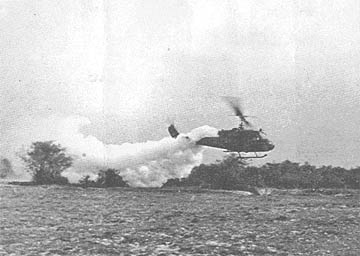 |
SMOKEY COVERS HOUNDS - A Hornet Smoke Ship of the 116th Assault Helicopter Company provides cover for choppers moving into a landing zone northwest of FSB Reed to drop off troops from the 2d Battalion, 27th Infantry. (PHOTO BY SP4 KARL KARLGAARD) |
Thanks to
Charles Lynch, 2nd Bn., 22nd Inf. for sharing this issue,
Bradley Hull, 2nd Bn., 22nd Inf. for locating and mailing it,
Karl Karlgaard, TLN correspondent, for sharing an issue with photos,
Kirk Ramsey, 2nd Bn., 14th Inf. for creating this page.
This page last modified 8-12-2004
©2004 25th Infantry Division Association. All rights reserved.